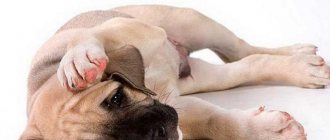Dogs constantly lick the external genitalia, so if there is discharge, the owner of the animal does not immediately notice the pathology. Discharge from the genital organs of an animal is a normal physiological process, but in some cases it is a sign of a dangerous disease. To determine the causes of the discharge, consultation with a specialist is necessary.
What kind of discharge does a pregnant dog have?
Discharge during pregnancy in dogs is a normal physiological phenomenon. They are always present in small quantities and provide balance to the mucous membrane of the dog’s genital tract (if the discharge is in a male, then this is for you).
Immediately after mating with a male dog, the bitch’s discharge, as expected, stops, by which the owner learns that the dog is in heat and is ready for fertilization. Instead, whitish-transparent thick drops may be released. This is a kind of reaction of the mucous membrane of the female genital tract to the seminal fluid of a male dog. It is possible that the discharge is light pink, spotting, and mucous. In the first days after mating the bitch - preliminary or control - this discharge should stop.
Three weeks after mating, if the bitch is fertilized, her cervix closes. This is accompanied by discharge that resembles water in consistency and transparency and has a slight admixture of mucus. Mucus is the excess mucus plug that covers the cervix. A slight presence of bloody inclusions is allowed in the plug - this is the release of unfertilized or fertilized, but dead, eggs.
About a month after fertilization, thick translucent mucus is released from the loop of the pregnant bitch. In nature, it forms a protective barrier, drying in the lumen of the loop and gluing it together after each urination. Dried mucus resembles a wound covered with ichorous crust. It is advisable to wash your pet dog with clean water without soap or wipe its loop with baby sanitary napkins or special wipes for veterinary use. If you do not remove the crust, hair will begin to stick to it, and the dog will look very unkempt.
Diagnostics
Any discharge from a dog's loop requires attention from its owner. But his particular concern, in addition to the above, should be:
- the occurrence of severe thirst;
- deterioration in coordination of movements;
- bloody trail after urination;
- swollen condition of the animal's loop.
If you notice at least one of these manifestations, your pet should be taken to the veterinarian. After all, such symptoms are a direct indication of the inflammatory process in the uterus. There the animal will be examined and the necessary tests will be performed, including:
- laboratory tests of blood and urine;
- bacteriological examination of the microflora of the urinary tract and vagina;
- vaginal smear for cytology;
- abdominal x-ray;
- Ultrasound;
- biopsy of vaginal abnormal tissue;
- examination of the vagina and cervix;
- test determination of possible damage by brucellosis and herpes;
- coagulation (for poor blood clotting), etc.
There are a lot of diagnostic methods, and they allow you to determine the exact picture of the illness, as well as prescribe appropriate therapy.
Black spots under the skin: demodicosis
This disease is caused by a tick. At the first stage, the skin is covered with a red rash, but over time it becomes covered with a dark crust, which is mistaken for blackheads. As the lesion progresses, hair falls out around the lesion. Shepherd dogs, Rottweilers, Great Danes, Boxers, Collies, Shelties, and French bulldogs are prone to the disease. Risk groups include puppies under 1 year of age and pets over 10 years of age.
More about diseases caused by ticks and their treatment in the article How to remove a tick from a dog. Ticks, piroplasmosis - signs, consequences, treatment. Types of ticks.
Treatment options
If a pathology is detected, it can be both surgical and medicinal:
- complete removal of the uterus or surgical removal of a foreign body found in it, as well as tumors;
- surgery to correct congenital changes in the rectum, vagina or ureters;
- antibacterial effect of drugs on infectious, bacterial lesions, inflammation resulting from injury
- drug therapy for poor blood clotting; chemotherapy when tumors are detected.
Simple pathologies allow treatment at home. True, the owner will need to make a lot of effort and be patient for this. It is important not only to strictly follow the veterinarian’s recommendations, but also to show your dog love, affection and care. In case of pathological discharge from your pet’s uterus, even of a minor nature, self-medication is not recommended. The end of such an attempt can be very sad.
Based on this, I would like to emphasize once again: as soon as you notice discharge from the loop in an animal that is not associated with estrus or the postpartum period, be sure to show it to a specialist who will determine the cause and prescribe treatment. After all, this is the only way to get rid of the problem in a timely manner and save his life.
The appearance of blood in the discharge
It is worth noting that such a signal is not always a consequence of pathology. If the discharge does not last long, the dog’s activity does not change in any way, the color of the blood is quite dark, and the amount of blood is small, then there is no serious cause for alarm.
Mostly 1-2 days before birth, a clear or white liquid is released from the loop, the consistency resembles the white of a chicken egg. In some cases, light green or brown mucus may appear. The brown color is a consequence of getting into the blood secretions. The reason is burst capillaries, as a result of dilatation of the cervix. There is nothing serious in this case; such a signal indicates an imminent birth. Eclampsia may occur.
It is normal for the mucus plug to peel off 20-40 hours before birth, which is accompanied by blood and yellowish mucus. In this case, the discharge may be insignificant and even unnoticeable.
If the discharge of blood is profuse and the mucus turns dark brown in color, it is likely that one puppy has died, which requires a visit to the veterinarian; birth at home cannot be performed. A large amount of dark or light blood may indicate that the uterus has ruptured; this is dangerous for the health of the animal and the fetus. The dog will need urgent hospitalization and help from a veterinarian.
It is normal for blood to appear for some time after childbirth, mostly healing occurs after 2-3 days. If blood clots continue to be released, there is a high risk of bleeding in the uterus, which can only be eliminated in the clinic with the help of hemostatic drugs, but they have many contraindications and therefore require medical supervision.
In general, excessive bleeding is always a sign of pathology. Small particles of red or brown color should alert the owner, but there is no need to take any action for treatment. It is advisable to consult a doctor.
The course of pregnancy after 1 month
At this stage, before the crust forms, long green or black clots may stretch from the loop - these are embryos that died in the early stages of pregnancy. There is nothing wrong with this; this is a normal scheme for cleaning a dog’s uterus provided by nature. If the dead embryos remain in the uterus, they will mummify and be expelled during childbirth. There is nothing dangerous in this either (a complete list of the course of pregnancy by day).
If the bitch is not fertilized, she also needs to be monitored. Such discharge, coupled with swollen milk bags and saggy nipples, may indicate a false pregnancy - an extremely undesirable hormone-dependent condition that negatively affects the reproductive health and psyche of the dog. A dog with signs of a false pregnancy should be taken to a veterinarian to evaluate the condition and possibly prescribe hormonal medications.
It will be informative about discopathy in dogs
24-36, sometimes 48 hours before whelping, the bitch’s mucous plug comes off. This is a clot of mucus of a transparent, whitish brown color. The release of the mucus plug is the first clear sign of the bitch preparing for childbirth. She becomes either very nervous or abnormally relaxed, looking for a nest, trying to dig a hole in the floor or in the yard, preparing a place for the puppies. During this period, the most peaceful, calm environment that can be created should be created for a pregnant dog. Some bitches seek the company of their owner, while others want complete privacy during childbirth. Your pet's choice should be respected, but you should constantly monitor her and be ready to help her.
When is veterinary care needed immediately?
In the following situations, professional help is recommended:
- When the discharge is bloody. This may be evidence of uterine rupture. Uterine rupture is a dangerous life-threatening condition in which only a highly qualified veterinarian can provide competent assistance. Most likely, it will not be possible to save the puppies; the uterus will also have to be removed. Veterinarians recommend removing the ovaries along with removing the uterus - castrating the dog in order to avoid false pregnancies due to “empty” heats and to prevent tumors of the milk bags.
- When a pregnant dog's discharge from the loop has a foul odor. This is usually a sign of inflammation when both the puppies and the bitch are infected. Timely assistance will help preserve the litter. The stench may indicate intrauterine death of the litter and the beginning of the decomposition process. In this case, immediate surgery is required to remove the dead puppies. Even if there are still living puppies in the uterus, the bitch will probably not be able to bear them, since they are infected and will die sooner or later
- When the discharge is green. Green discharge is also a clear sign of infection, and intrauterine. They may also indicate placental abruption. Both conditions are dangerous for both the pregnant dog and the premature litter.
- When pus is released from the loop. This means that the inflammatory process in the uterus develops rapidly and is aggravated by the general weakened state of the dog’s body.
Comments
Mixed colors are formed by a combination of two pigments in the absence of white. Depending on the distribution of eumelanin and pheomelanin, five main types of coloring are distinguished: red with a black mask, red with darkening, brindle, black with red spots (tan), red with a saddle. Variations in the main types of coloring are due to lightening (for example, sand with a blue mask), as well as the distribution of pigmented hair over the dog’s body. The mask can be combined with the other four colorings. The red color with darkening is formed when both pigments are present in the hair, forming zones of black (brown) and red pigmentation (the so-called “zonal” or “agouti” color). Due to the fact that the distribution of pigment zones in the hair can vary, a huge variety of colors is possible. When the pigment in the hair alternates, a “wolf” color is formed. When the black pigment is concentrated only at the end of the hair, the result is a “sable” color. When dark areas form vertical stripes on a dog's body, they are said to be brindle. Black pigment, distributed on the face and often on the front of the head up to the ears, forms a mask. The area of black hair on the dog's back, extending down to the sides and hips, is called the saddle. Tan marks are clearly defined red spots located in certain places on the dog’s body.
Acanthosis nigricans in dogs is one of the most severe forms of skin diseases. Every year, thousands of dogs are diagnosed with various skin diseases in different parts of the world. Animals from such pathologies almost completely lose their selection attractiveness and value or simply die.
The disease is characterized by the fact that a huge amount of melanin accumulates in the animal’s skin, baldness begins and rather sharply thickening of the skin or lichenification occurs, which is due to genetic origin. Dark spots under the armpits are not natural for dogs. Thickened skin in such a delicate area is a sign of a disease that needs to be treated at the earliest stage of development.
Causes and symptoms
There are natural (normal) reasons that lead to the appearance of a liquid substance from the vagina of a bitch. Such natural reasons include:
- childbirth. During the postpartum period, the bitch experiences the appearance of dark brown droplets, which can last 2 or even 3 weeks;
- estrus. In this case, bloody discharge appears from the vagina during estrus in dogs, as a signal that the bitch is ready for mating and fertilization.
The duration of the appearance of blood depends on the breed and size of the animal, but as a rule this period lasts several days.
But there are many more reasons for “abnormal” discharge, and each of them is a reason to visit the veterinarian. So, after giving birth, a dog may develop watery drops from the vagina, caused by the placenta that has not left. This process is pathological and requires contacting a veterinarian.
Pathological processes include the appearance of a liquid substance from the vagina before estrus and after childbirth. Also, the appearance of fluid from a dog’s vagina during pregnancy is positioned as pathological and can signal problems when bearing puppies. In this case, the color of the substance (white discharge, brown, bloody) does not matter. The appearance of fluid from the loop during pregnancy is always a signal of a problem that requires immediate analysis.
In the presence of urogenital infections such as infections of the uterus or urinary tract, vaginal discharge also appears. In this case, the liquid can be either pinkish or greenish (purulent). If your dog has purulent discharge after estrus, you should immediately contact a specialist. Since one of the reasons why purulent discharge appears from the loop is pyometra, which is considered a very dangerous pathology, contacting a specialist is not only desirable, but mandatory.
Bloody or purulent discharge also accompanies pathologies such as cancer (neoplasia) of the urogenital tract. Accordingly, if the owner sees that his pet has purulent, brown or greenish liquid droplets appearing from the loop, which appear both before and after estrus, and even during it, then you need to go to the clinic and show the pet to a specialist.
How to care for a dog after giving birth?
The best way to prevent negative consequences is to properly care for your pet:
- Wash the animal immediately after birth with laundry soap and dry gently with a soft cloth.
- Don't force your dog to walk when it doesn't want to;
- Ensure peace, protect from visitors;
- Place a bowl of clean water nearby. You can give warm tea with a little honey (not sugar!). Milk is prohibited;
- Do not feed the dog immediately after giving birth, it is better to do this at the request of the pet;
- Wash paws, belly, buttock area and anus after walking and defecating. It is better to use a solution of potassium permanganate or other available antiseptics;
- Change the litter once a day or more often as needed. The fabric should not be wet or dirty;
- Once every 5-7 days, you can rinse the vagina with syntomycin emulsion using a syringe;
- Limit activity in the first 2-3 days;
- If there is bleeding or discharge with an unpleasant odor, as well as in combination with other alarming signs, you should contact your veterinarian immediately.
Possible treatment options
If a dog has vaginal discharge, a specialist may prescribe both medication and surgery. Of course, if this is natural discharge (during estrus or the postpartum period), then no treatment is required.
If we are talking about a pathological phenomenon (white discharge, purulent, brown, etc.), then this is usually:
- surgical removal of the infected uterus. A foreign body, vaginal or uterine tumor must also be removed;
- surgical correction of congenital pathologies of the ureter, rectum or vaginal walls;
- drug treatment with antibiotics to eliminate the presence of infections, bacteria or inflammation caused by injury;
- drug therapy if a problem with blood clotting is identified;
- treatment with chemotherapy (indicated in the presence of tumors).
If eliminating the discharge does not require surgical intervention or complex drug therapy, then you can help your pet get rid of the problem at home. True, this will require a lot of effort and follow the recommendations of a specialist. During treatment, you need to be patient and before starting to solve the problem, be sure to show your pet to a veterinarian.
What to do on your own in dangerous situations?
Before the dog gets into the hands of veterinarians, the process of blood loss can be slightly slowed down. Ice compresses must be applied to the pet's lower abdomen and sacrum and ensure a motionless position.
If the temperature rises to critical levels (and in dogs it is more than 41 degrees), it is necessary to place the pet in a cool place and give it clean water to drink. If the animal refuses to drink, pour a little into the mouth from a syringe without a needle.
Carefully! You cannot give antipyretic drugs to people on your own; the wrong dosage will lead to serious complications.
High danger
The cause of discharge from the loop in a dog may be the presence of one of such dangerous diseases as venereal sarcoma, pyometra or hemometra.
With purulent inflammation of the uterus, that is, with pyometra, vaginal discharge has a greenish purulent appearance and the solution to the problem involves immediate surgical intervention. Considering that the mortality rate is very high, treating pyometra is a matter of life and death for a dog. Therefore, all vaginal discharge that is brown, yellowish or reddish in color, and which is not a sign of estrus, should alert the owner and cause an emergency visit to the clinic.
As for treatment, today the only correct method is surgical intervention. There is also a preventive technique - sterilization. But this solution is only suitable for those dogs that are not planned for further mating and procreation.
You should not self-medicate an animal, as this can end very sadly for your pet. In addition, you lose valuable time. Therefore, as soon as you see that your dog has discharge from the loop (not during estrus or during the postpartum period), be sure to show your pet to an experienced veterinarian who will conduct a full examination and make an accurate diagnosis. After all, this is the only way to prescribe the correct treatment, which will relieve your pet of the problem, and perhaps even save his life.
Diseases of the genital organs almost always affect the general health of dogs, and in females this connection is more pronounced. Yellow discharge in dogs can be either physiologically caused or pathological. In each case, you should visit a veterinarian - it is better to make sure once again that everything is in order, and the discharge corresponds to the physiological state of the animal, than to miss serious pathologies of the reproductive system.
Pathologies with discharge in males
Yellow discharge from the penis may be a sign of:
- posthitis, balanitis, balanoposthitis (inflammation of the penis, prepuce, or both). With such pathologies, the discharge has a dull yellow or yellow-green color, the discharge is constantly present in the preputial fold, the penis and the area around it are red, painful, swollen, and hot.
- prostatitis. Mucous-yellow or mucous-cloudy-pink discharge is accompanied by anxiety, pain when urinating and changes in the shape of feces (with severe inflammation, the prostate enlarges so much that it compresses the feces).
- inflammatory process in the bladder and/or urethra (urethra). The discharge is yellow, translucent, most often in the form of drops at the tip of the glans penis. In case of acute inflammation, it may turn pink or red - evidence of the presence of blood in the urine.
- urolithiasis. Discharges are often similar to those that appear during inflammation of the genitourinary system. Accompanied by pain when urinating or the absence of it at all;
- hidden sexually transmitted infections (ureaplasmosis, mycoplasmosis, chlamydia, herpes, etc.). It can only be determined by laboratory tests;
- urinary incontinence. With this disease, a male dog will have yellow discharge from the penis with droplets of urine.
An important feature: in almost all pathological cases, the male pays increased attention to his genitals, constantly licking them.
When should you see a doctor?
- if the discharge is heavy or bloody,
- if the discharge comes directly from the urethra,
- if you cannot examine the penis yourself or it causes obvious pain to the animal,
- if you find any formations on the penis or severe redness on it.
ATTENTION!! If, in addition to discharge, you notice any problems with urination in an animal (difficulty, pain, lack of urination), you should contact a doctor URGENTLY!
Pathologies with discharge in bitches
Yellow discharge from the loop occurs when:
- urinary incontinence - yellowish discharge in the form of droplets of urine is almost always found on the genital slit;
- uterine subinvolution - a delay in restoration of normal size after birth, when sticky, yellow-red discharge continues to appear for 3-4 weeks after the puppies are born;
- endometritis – inflammation of the uterine mucosa;
- vaginitis - inflammation of the vaginal mucosa (discharges are very similar to those that appear during estrus);
- juvenile vaginitis - inflammation that is recorded in female puppies before puberty against the background of endocrine disorders;
- pyometra – purulent inflammation of the uterus. This is the most common reason when a dog’s discharge appears after estrus (yellow, yellow-green, cloudy green, with a pungent, unpleasant odor);
- hydrometer - inflammation of the uterus, when not pus, but fluid and transudate accumulate in its cavity. The discharge can be transparent yellow, liquid or mucous. Often confused with pyometra;
- tumors in the genital organs, when, against the background of mechanical compression, natural secretions stagnate and come out with a delay and changed in color and consistency;
- venereal sarcoma - symptoms are often confused with estrus, the color of the discharge varies from cloudy white, yellow to red (bloody), when the process of oncological decomposition is started;
- stump - the reason for the appearance of discharge in a sterilized bitch when the postoperative stump becomes inflamed;
- recurrent ovary syndrome - when, after sterilization, part of the ovarian tissue remains in the abdominal cavity, which produces sex hormones and discharge periodically appears, as during estrus.
Skin diseases
Pus appears due to pyoderma. The main reason for its occurrence is decreased immunity. Most often, the disease affects dogs that have changed their diet or place of residence.
Helminthic infestations, parasites, and injuries lead to a decrease in the body's defenses. Also, purulent inflammation of the skin develops with insufficient hygiene, restriction of the dog’s physical activity or excessive stress.
Pyoderma is caused mainly by microbes that constantly live on the skin of animals. If pustules appear on the paws, they may be caused by pathogens living in the soil.
At first, the animals are bothered by severe itching, then red spots and small ulcers appear on the skin. When scratched, they open, a foul-smelling liquid is released, and the infection spreads.
Subsequently, hair begins to fall out on the neck, back, stomach and other affected areas. The skin is exposed, redness, blisters are visible on it, with a large content of pus inside, erosion and ulcers.
On other parts of the body, the fur becomes dull and sticks together. The disease lasts for years without proper treatment. Wounds on dogs do not heal well, leading to blood poisoning and death.
Ears, eyes
Cases of purulent inflammation are even more frequent than pyoderma. Otitis media is caused by injuries, poor hygiene, parasites and worms.
Inflammation can occur due to allergies, when a dog begins to intensively scratch its ears and an infection gets there.
Fold-eared breeds are more prone to otitis, since they do not have sufficient ear ventilation, moisture and dirt accumulate (an ideal environment for the proliferation of microbes).
At the first symptoms of otitis media, the dog begins to scratch, shakes its head, and tilts it to the affected side. On examination, you may see redness, swelling and pus. The canal and auricle are covered with yellowish or brown crusts.
When touched, the dog reacts painfully, shakes its head, may whine, and it feels hot to the touch. General symptoms appear - fever, loss of appetite, fatigue. Why does my dog have pus coming out of his eyes? A common cause of this condition is allergies, injuries, viral diseases, which are accompanied by a bacterial infection. When your nose runs, conjunctivitis can occur very quickly.
After all, the lacrimal glands open into the nasal cavity, which makes it easy for infections to spread to the bag, conjunctiva and eyeball. Inflammation may also occur due to blockage of the duct, injury, irritation from dust or chemicals.
Sometimes the cause is parasites or general diseases that lead to decreased immunity. First, the animal develops redness, swelling, increased lacrimation, then white pus of the eyes, which oozes from the corners.
If the problem is not treated, very soon you will see green pus in your eyes. This means that bacteria multiply in the mucous membranes, which leads to more intense coloration of the discharge.
In the morning, the dog has difficulty opening his eyelids, and the skin around them is irritated. The dog becomes lethargic, constantly rubs his eyes with his paws, and eats poorly. If conjunctivitis is not a complication, the temperature in animals rarely rises.
Genitourinary system
When a dog has pus coming out of its pee or discharge from the vagina, this may indicate an infection in the bladder or genitals. Bitches are most often diagnosed with pyometra - purulent inflammation in the uterus.
It can occur in two forms. In the first case, there is discharge of pus from the vagina, lethargy, loss of appetite, frequent urination, and sometimes diarrhea. In the second case, the dog exhibits only general symptoms, the temperature rises, and sometimes the abdomen enlarges.
There is no discharge, which is an unfavorable factor; the disease is more severe. Pus from the penis in a male dog most often begins to discharge due to balanoposthitis, inflammation of the glans penis and prepuce.
It appears in a dog when there is stagnation of sperm and urine, followed by infectious infection. The cause may be phimosis, uncontrolled mating, tumors, and improper hygiene.
The dog behaves restlessly, constantly licks the genitals, and refuses contact. In severe cases, she becomes lethargic and develops a fever.
Discharge of pus from the urethra in a dog can be a symptom of prostatitis, inflammation of the bladder or urethra, or urolithiasis.
In bitches with such infections, it is often simply diluted with pus, and there is no discharge from the canal, or it is almost invisible.
Infections of the entire system are provoked by various flora (Escherichia coli, streptococci and staphylococci). Inflammations caused by chlamydia, mycoplasma or ureaplasma occur covertly.
Intestines
Pus can come out of a dog’s butt for several reasons. Most often, this is how damage to the anal glands manifests itself. They are located near the anus; during defecation, they release a specific liquid into the lumen of the rectum.
When the glands are full, they become inflamed, enlarged, swollen and red. The dog begins to fidget on the floor, sometimes refuses to sit, and may develop an asymmetrical gait.
Small breed dogs are more often affected by this disease. Discharge of pus from the anus can also occur with intestinal diseases.
For example, with ulcerative colitis, discharge appears from a loop of the sigmoid colon, exits through the rectum along with feces or independently. Symptoms can also be caused by proctitis or intestinal pathology.
Treatment
What to do when pus appears? The first thing you should do is contact your veterinarian. Only an experienced specialist can make the correct diagnosis and tell you how to treat this or that infection.
In most cases, animals are prescribed topical or general antibiotics. If pus appears in the ear, it is recommended to instill ear drops and clean the shell of crusts.
For otitis, antibiotic injections are used. Pyoderma is treated with local medications, immunomodulators and injectable anti-inflammatory drugs are prescribed.
How to wash a dog's eyes? It is best to use herbal decoctions (chamomile, calendula, yarrow) at home. Veterinarians also recommend a weak solution of furatsilin.
You should definitely buy eye drops with an anti-inflammatory or antibacterial effect at the pharmacy. They must be special for dogs; not all human preparations are suitable.
How to treat infections of the genitourinary system and intestines? Here it is better to immediately contact a veterinarian. Some of these infections are severe and lead to the death of the animal. For example, pyometra (especially closed) is often complicated by sepsis. And when the anal glands become inflamed, an abscess easily occurs.
In this article I will talk about why purulent discharge appears from a dog’s urethra. I will give the main reasons for this phenomenon. I will describe the process of diagnosing diseases associated with the appearance of pus. I'll tell you how this condition is treated.
Contributing factors to the disease
Hyperpigmentation is the crux of acanthosis in dogs. It does not depend at all on the age and gender of the dog. In its primary form, the disease manifests itself as genodermatosis, which is genetically determined. It can be found in most dogs, regardless of breed.
It should be noted that dachshunds of all varieties have a special predisposition to it. Already in the first year of life, representatives of this breed begin to develop typical signs of this pathology.
Post-inflammatory hyperpigmentation of the skin or secondary acanthosis is detected much more often. It can be detected in dogs of any age. It usually develops as a consequence of past illnesses, which are accompanied by various kinds of inflammation in the groin area and under the armpits. Dark spots on dogs' skin appear due to hyperpigmentation.
- hypothyroidism;
- conformational disorders;
- food allergies;
- obesity;
- hypercortisolism;
- allergic dermatitis;
- pathologies of the genital organs;
- independent skin infections;
- keratinization disorders.
As a result of a failure in the production of melanin, which is the pigment of the skin, significant discoloration may be observed in the affected area. The epidermis in these places undergoes excessive keratinization and is covered with abundant secretions of the sebaceous glands. It also becomes much thicker and can burst easily.
Most often, changes occur under the animal’s paws. However, if the disease takes the form of more advanced lesions, they are also found on the dog's bridge, groin and inner thighs.
Causes, symptoms
The disease is caused by pathogenic microflora. The skin of the glans penis and prepuce swells. Inflammation can spread to the urethra and testes. A severe form of balanoposthitis leads to the development of urethritis, orchitis and peritonitis.
Sometimes this pathology is a genetic defect. It is especially common in German Shepherds and Golden Retrievers.
The reasons may be:
- mating with infected bitches;
- decreased immunity, poor nutrition and poor living conditions;
- stagnation of urine and sperm in the preputial sac;
- diabetes;
- injuries in the genital area - cuts, scratches, tears, etc.;
- obesity;
- urolithiasis disease;
- the presence of adhesions and tumors;
- poor hygiene;
- purulent urethritis;
- foreign body under the foreskin (for example, grains of sand, small debris);
- allergies;
- aggressive collisions with other animals resulting in injuries to the groin area.
A factor in the development of the disease is often phimosis, which causes “shrinking” of the foreskin. As a result, the head remains open constantly, which leads to swelling, inflammation and drying out of the mucous membrane, on which cracks form. They become the “gateway” for infection.
The disease mainly affects adult dogs. In rare cases, balanoposthitis occurs in puppies.
You should pay special attention to a male dog if he constantly licks and scratches his prepuce. Signs of the disease:
- at the end of the penis the hair is glued together with pus. When the head is exposed, a large accumulation of secretion is discovered;
- unpleasant odor;
- visible erosion, small wounds;
- inflamed skin in the groin area;
- due to pain, the male does not allow touching the penis;
- small blisters with liquid (herpetic type) at the base of the penis.
The skin around the external opening of the prepuce is the first to tear.
Next it moves to the mucous membrane. The prepuce swells and turns red. Painful sensations occur. Purulent exudate glues the hair adjacent to the hole. After drying, crusts form, under which ulcers, erosions, and ulcers appear.
Balanoposthitis can be:
- a simple form, when small ulcers are noted on the mucous membrane of the head of the penis and foreskin;
- erosive. Accompanied by whitish growths. When they burst, they form eroded areas;
- pustular - ulcerative was named due to the formation of a large number of small pustules with dark yellow contents. The collapse of pustules leads to the formation of deep ulcers;
- follicular. Upon palpation, small dense nodules (follicles) are felt;
- acute form. Characterized by foci of inflammation on the foreskin, enlarged lymph nodes, increased body temperature;
- gangrenous - accompanied by high fever and general weakness of the dog;
- chronic. As a result of cracking of the mucous membrane of the head of the penis, the dog constantly experiences pain. Scarring of tissue causes phimosis. Local lymph nodes enlarge, body temperature rises.
They begin with an examination of the genital organs. If symptoms of balanoposthitis are detected, contact a veterinary clinic. There they find out the nature of the microflora - pathogenic or not. The presence of tumors and adhesions is excluded.
The veterinarian takes swabs and swabs, which are sown on nutrient media. This allows you to determine the type of microorganism that caused the disease and prescribe effective treatment.
Treatment
In the absence of severe symptoms, when only superficial tissues are affected, balanoposthitis can be successfully treated at home. For several days, the preputial cavity of the male dog is washed 2-3 times a day with hydrogen peroxide or furatsilin. If the disease becomes more severe, use Chlorhexidine, Miramistin or Dioxidine.
The home procedure is carried out together. It’s good if someone close to you helps. The male is fixed in a lying position: laid on his side on a stable surface and held by his front paws so that he cannot bite.
Raise the hind paw and place a wide container under the penis. The procedure is carried out with a small syringe with a soft tip or a syringe (volume 20 ml), without touching the surface of the penis. Retract the foreskin and wash the inflamed areas.
It is necessary that the solution reaches the entire space under the foreskin. Close the preputial sac with your fingers and gently massage. Unclench the foreskin and drain the solution. The last step is to expose the head of the penis and apply a thin layer of ointment, which has a healing and antimicrobial effect.
To prevent the dog from licking the genitals, a special post-operative collar (“Elizabetinsky”) is worn.
If the disease is advanced or has become chronic, treatment of balanoposthitis in dogs is carried out in a veterinary clinic. At this stage, any touch causes severe pain, and the animal will not allow an examination. It may be necessary to use strong sedatives to calm him down.
The doctor conducts an examination for the presence of adhesions, tumors, and other possible causes of phimosis and balanoposthitis. One of the reasons for balanoposthitis may be decreased immunity. In this case, the doctor will prescribe immunomodulators.
Washing of the preputial sac is done with antiseptic solutions in high concentrations. It is possible to introduce liniments into the preputial cavity. If the condition worsens, antibiotic therapy is administered.
In extreme cases (gangrene), surgery will be needed to remove dead tissue, adhesions and scars. Sometimes complete castration is required to completely get rid of the disease and save the life of a male dog.
Affordable treatment for acanthosis nigricans in animals
A veterinarian can only delay the development of the disease and prevent serious relapses. Treatment is also aimed at eliminating secondary infections, eliminating itching and stimulating epidermal repair. Sometimes therapy uses thyroid hormones and thyroid hormone analogues. Some veterinarians use melatonin, and mineral and vitamin supplements, unsaturated omega-3 and omega-6 fatty acids are also important. Shampoos containing selenium sulfide with anti-oil effects are also useful.
When treating this pathology, veterinarians also prescribe:
- a course of vitamin E for two to three months;
- a weekly course of systemic glucocorticoids according to the “every other day” scheme;
- a seven-day course of taking melatonin.
In parallel, antimicrobial therapy and a course of treatment of bacterial infections are carried out. Antiseborrheic shampoos are widely used during treatment. They are recommended to be used two to three times a day in severe cases of the disease.
Often, when secondary acanthosis occurs, the dog immediately recovers after the root cause of the disease has been identified and destroyed. But, even after a course of treatment, some areas of dark hyperpigmentation of the skin may still remain on the body. It is imperative to check the animal for the presence of any pathogen, because any ingrained form of infection can be identified, which can affect the recurrence of the disease, as with otitis media.
Acanthosis nigricans in dogs is not at all contagious. This is a genetic form of the disease and is not transmitted to humans, as it is a specific disease of dogs. The main thing is not to let the disease progress and, if possible, contact a veterinarian as soon as possible.
Darkening of a dog's skin can be caused by many reasons and can be either hereditary or acquired. Black or brown spots are often a sign of hormonal imbalance, metabolic disorders, atopic dermatitis, but the disease can be much more dangerous: for example, one of the most aggressive malignant tumors, melanoma, also manifests itself. How is acanthosis diagnosed and how is it treated?
Men's health with genital discharge in dogs
Immediately after the end of the mating, you can observe how a cloudy white liquid or with traces of blood with a sharp specific odor is released from the bitch’s vagina - this is an absolutely normal phenomenon! This liquid is not sperm, but an excess of secretion from the bitch’s genitals, which served as a lubricant during mating. And therefore it is inappropriate to prevent its leakage. Just let the dogs lick their genitals, give the animals water to drink.
The male dog needs to wash the prepuce (the fold of skin that hides the end of the penis) with chlorhexidine - it is an antiseptic.
It happens that after a decline in excitement, the head of the male penis cannot return to this same preputial sac, for example, due to hair that has gotten inside the sac. In this case, you need to wash the penis with cold boiled water, which will cause a rapid outflow of blood from the penis, and at the same time carefully straighten the curled edges of the foreskin. You need to act immediately, without relying on chance. You can try lubricating the head with Vaseline oil and try to pull the skin of the prepuce onto the penis.
If your actions cause severe pain to the dog, and attempts to help are unsuccessful, immediately seek help from a veterinarian.
If you do not perform this operation, you risk causing harm to your pet's health. And to solve the problem you will have to go to the veterinary clinic.
It is extremely important to examine the male dog after mating, because if the head of the penis, which cannot return to the prepuce, swells from edema, it will begin to cause extremely unpleasant sensations, even severe pain, to the male dog.
If it so happens that there is no “lock”, the male’s penis will immediately be freed, and the male will walk around with his genitals exposed until the blood drains from him. What happened is not harmless to the dog’s health, because the exposed penis will quickly dry out and may crack. In this case, the owner of the male dog will need to wet his pet’s penis with cool boiled water using a syringe while it is in this state. Just in case, you can prepare a glass of cold boiled water in advance and place your penis in it for a few seconds. The blood will begin to drain, the penis will shrink and return to the prepuce.
Then you need to give the dog a rest, but make sure that he does not meet other dogs who find out about your dog’s valiant deeds and begin to envy him, after which a fight may occur.
After mating, the bitch must be wiped dry.
After the mating is over and all hygiene procedures have been completed, the owner of the bitch can return home, because if the dogs are not separated, after a while the male may again have the strength to have sexual intercourse again. This doesn't make much sense, so don't make a tired bitch relive this. Upon arrival home, provide her with rest (at least 2 hours) in a cozy and comfortable place. A couple of hours after mating, you can take the girl for a walk.
But if you come from afar for mating, in order to avoid unnecessary stress, postpone your trip home until the next day.
On the day of mating, while out for a walk, you should carefully monitor your ward, under no circumstances let her off the leash and not allow other willing males to approach her, and protect her from stress. Provide your pet with the best care, feeding and walking.
After mating, Spitz dogs should be fed at the usual time, on a schedule, or when they ask for food.
The next two months after mating, your pet’s body will undergo significant changes and stress, and how she will experience this period of time depends directly on you.
Interesting points
There is such an observation: if mating occurs during the waxing of the moon, then the bitch will not be empty. Naturally, if it is carried out during ovulation.
If you breed a bitch in the first days of the hunt, then most likely there will be more boys in the litter, and if in the last days, then there will be more girls. This phenomenon has not been studied; this may probably be due to changes in the level of acidity in the female reproductive tract.











